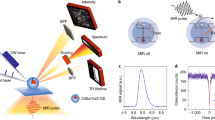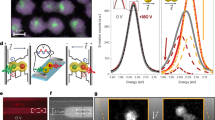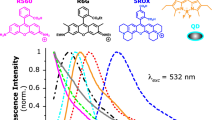Abstract
At a single-molecule level, fluorophore emission intensity fluctuates between bright and dark states. These fluctuations, known as blinking, limit the use of fluorophores in single-molecule experiments. The dark-state duration shows a universal heavy-tailed power-law distribution characterized by the occurrence of long non-emissive periods. Here we have synthesized novel CdSe–CdS core–shell quantum dots with thick crystalline shells, 68% of which do not blink when observed individually at 33 Hz for 5 min. We have established a direct correlation between shell thickness and blinking occurrences. Importantly, the statistics of dark periods that appear at high acquisition rates (1 kHz) are not heavy tailed, in striking contrast with previous observations. Blinking statistics are thus not as universal as thought so far. We anticipate that our results will help to better understand the physico-chemistry of single-fluorophore emission and rationalize the design of other fluorophores that do not blink.
This is a preview of subscription content, access via your institution
Access options
Subscribe to this journal
Receive 12 print issues and online access
$259.00 per year
only $21.58 per issue
Buy this article
- Purchase on Springer Link
- Instant access to full article PDF
Prices may be subject to local taxes which are calculated during checkout




Similar content being viewed by others
References
Orrit, M. & Bernard, J. Single pentacene molecules detected by fluorescence excitation in a para-terphenyl crystal. Phys. Rev. Lett. 65, 2716–2719 (1990).
Xie, X. S. & Dunn, R. C. Probing single-molecule dynamics. Science 265, 361–364 (1994).
Moerner, W. E. & Orrit, M. Illuminating single molecules in condensed matter. Science 283, 1670–1673 (1999).
Mason, M. D., Credo, G. M., Weston, K. D. & Buratto, S. K. Luminescence of individual porous Si chromophores. Phys. Rev. Lett. 80, 5405–5408 (1998).
Nirmal, M. et al. Fluorescence intermittency in single cadmium selenide nanocrystals. Nature 383, 802–804 (1996).
Kuno, M., Fromm, D. P., Hamann, H. F., Gallagher, A. & Nesbitt, D. J. ‘On’/‘off’ fluorescence intermittency of single semiconductor quantum dots. J. Chem. Phys. 115, 1028–1040 (2001).
Kuno, M. et al. Fluorescence intermittency in single InP quantum dots. Nano Lett. 1, 557–564 (2001).
Hoogenboom, J. P., Hernando, J., van Dijk, E., van Hulst, N. F. & Garcia-Parajo, M. F. Power-law blinking in the fluorescence of single organic molecules. ChemPhysChem 8, 823–833 (2007).
Hoogenboom, J. P., van Dijk, E., Hernando, J., van Hulst, N. F. & Garcia-Parajo, M. F. Power-law-distributed dark states are the main pathway for photobleaching of single organic molecules. Phys. Rev. Lett. 95, 097401 (2005).
Schuster, J., Cichos, F. & von Borczyskowski, C. Influence of self-trapped states on the fluorescence intermittency of single molecules. Appl. Phys. Lett. 87, 051915 (2005).
Kuno, M., Fromm, D. P., Hamann, H. F., Gallagher, A. & Nesbitt, D. J. Nonexponential ‘blinking’ kinetics of single CdSe quantum dots: A universal power law behavior. J. Chem. Phys. 112, 3117–3120 (2000).
Brokmann, X. et al. Statistical aging and nonergodicity in the fluorescence of single nanocrystals. Phys. Rev. Lett. 90, 120601 (2003).
Margolin, G., Protasenko, V., Kuno, M. & Barkai, E. Photon counting statistics for blinking CdSe–ZnS quantum dots: A Levy walk process. J. Phys. Chem. B 110, 19053–19060 (2006).
Zondervan, R., Kulzer, F., Orlinskii, S. B. & Orrit, M. Photoblinking of rhodamine 6G in poly(vinyl alcohol): Radical dark state formed through the triplet. J. Phys. Chem. A 107, 6770–6776 (2003).
Shimizu, K. T. et al. Blinking statistics in single semiconductor nanocrystal quantum dots. Phys. Rev. B 6320, 205316 (2001).
Kuno, M., Fromm, D. P., Johnson, S. T., Gallagher, A. & Nesbitt, D. J. Modeling distributed kinetics in isolated semiconductor quantum dots. Phys. Rev. B 67, 125304 (2003).
Frantsuzov, P. A. & Marcus, R. A. Explanation of quantum dot blinking without the long-lived trap hypothesis. Phys. Rev. B 72, 155321 (2005).
Mohamed, M. B., Tonti, D., Al-Salman, A., Chemseddine, A. & Chergui, M. Synthesis of high quality zinc blende CdSe nanocrystals. J. Phys. Chem. B 109, 10533–10537 (2005).
Talapin, D. V. et al. Highly emissive colloidal CdSe/CdS heterostructures of mixed dimensionality. Nano Lett. 3, 1677–1681 (2003).
Yu, Z. H., Guo, L., Du, H., Krauss, T. & Silcox, J. Shell distribution on colloidal CdSe/ZnS quantum dots. Nano Lett. 5, 565–570 (2005).
Hohng, S. & Ha, T. Near-complete suppression of quantum dot blinking in ambient conditions. J. Am. Chem. Soc. 126, 1324–1325 (2004).
Zhang, K., Chang, H. Y., Fu, A. H., Alivisatos, A. P. & Yang, H. Continuous distribution of emission states from single CdSe/ZnS quantum dots. Nano Lett. 6, 843–847 (2006).
Gomez, D. E., van Embden, J., Jasieniak, J., Smith, T. A. & Mulvaney, P. Blinking and surface chemistry of single CdSe nanocrystals. Small 2, 204–208 (2006).
Heyes, C. D., Kobitski, A. Y., Breus, V. V. & Nienhaus, G. U. Effect of the shell on the blinking statistics of core–shell quantum dots: A single-particle fluorescence study. Phys. Rev. B 75, 125431 (2007).
Ithurria, S., Guyot-Sionnest, P., Mahler, B. & Dubertret, B. Mn2+ as a radial pressure gauge in colloidal core/shell nanocrystals. Phys. Rev. Lett. 99, 265501 (2007).
Cichos, F., von Borczyskowski, C. & Orrit, M. Power-law intermittency of single emitters. Curr. Opin. Colloid Interface Sci. 12, 272–284 (2007).
Efros, A. L. & Rosen, M. Random telegraph signal in the photoluminescence intensity of a single quantum dot. Phys. Rev. Lett. 78, 1110–1113 (1997).
Tang, J. & Marcus, R. A. Diffusion-controlled electron transfer processes and power-law statistics of fluorescence intermittency of nanoparticles. Phys. Rev. Lett. 95, 107401 (2005).
Tang, J. & Marcus, R. A. Mechanisms of fluorescence blinking in semiconductor nanocrystal quantum dots. J. Chem. Phys. 123, 054704 (2005).
Verberk, R., van Oijen, A. M. & Orrit, M. Simple model for the power-law blinking of single semiconductor nanocrystals. Phys. Rev. B 66, 233202 (2002).
He, H., Qian, H. F., Dong, C. Q., Wang, K. L. & Ren, J. C. Single nonblinking CdTe quantum dots synthesized in aqueous thiopropionic acid. Angew. Chem. Int. Ed. 45, 7588–7591 (2006).
Muller, J. et al. Air-induced fluorescence bursts from single semiconductor nanocrystals. Appl. Phys. Lett. 85, 381–383 (2004).
Acknowledgements
We thank P. Guyot-Sionnest for critical and enlightening discussions concerning the work and the redaction of the manuscript. B.M. thanks T. Pons for providing the software code for the automated analysis of QD blinking. B.D. thanks the Human Frontier Science Program for funding. B.D. and J.-P.H. acknowledge funding from l’Agence Nationale de la Recherche and La Région Ile-de-France.
Author information
Authors and Affiliations
Corresponding authors
Supplementary information
Supplementary Information
Supplementary Figures S1–S3 (PDF 886 kb)
Rights and permissions
About this article
Cite this article
Mahler, B., Spinicelli, P., Buil, S. et al. Towards non-blinking colloidal quantum dots. Nature Mater 7, 659–664 (2008). https://doi.org/10.1038/nmat2222
Received:
Accepted:
Published:
Issue Date:
DOI: https://doi.org/10.1038/nmat2222
This article is cited by
-
Colloidal quantum dot electronics
Nature Electronics (2021)
-
Highly versatile near-infrared emitters based on an atomically defined HgS interlayer embedded into a CdSe/CdS quantum dot
Nature Nanotechnology (2021)
-
All-optical fluorescence blinking control in quantum dots with ultrafast mid-infrared pulses
Nature Nanotechnology (2021)
-
Exciton Stability and Luminescence in InN/(In,Ga)N Quantum Dots Under Size and Shell Content Effects
International Journal of Theoretical Physics (2021)
-
Hybrid material of structural DNA with inorganic compound: synthesis, applications, and perspective
Nano Convergence (2020)



